Spatiotemporal Dynamics and Driving Factors of Small and Micro Wetlands in the Yellow River Basin from 1990 to 2020
Abstract
1. Introduction
2. Materials and Methods
2.1. Study Area
2.2. Data Sources
2.3. Methods and Techniques
2.3.1. SMWs Dynamic Analysis
2.3.2. Analysis of Transition between SMWs and Land Use Types
2.3.3. Analysis of Driving Factors behind SMWs Changes
Factors Selection
The Geodetector Model
- (1)
- Differentiation and factor detector
- (2)
- Interaction detector
3. Results
3.1. Dynamic Changes in SMWs in the Yellow River Basin
3.2. Relationship between SMWs and Land Use in the Yellow River Basin
3.3. Analysis of Driving Factors in SMWs Distribution Changes
4. Discussion
4.1. Accuracy of SMWs Extraction
4.2. Drivers of SMWs Changes
4.3. Limitations in this Study
5. Conclusions
Author Contributions
Funding
Data Availability Statement
Acknowledgments
Conflicts of Interest
References
- Fluet-Chouinard, E.; Stocker, B.D.; Zhang, Z.; Malhotra, A.; Melton, J.R.; Poulter, B.; Kaplan, J.O.; Goldewijk, K.K.; Siebert, S.; Minayeva, T.; et al. Extensive Global Wetland Loss over the Past Three Centuries. Nature 2023, 614, 281–286. [Google Scholar] [CrossRef] [PubMed]
- Gordon, B.; Lenhart, C.; Peterson, H.; Gamble, J.; Nieber, J.; Current, D.; Brenke, A. Reduction of Nutrient Loads from Agricultural Subsurface Drainage Water in a Small, Edge-of-Field Constructed Treatment Wetland. Ecol. Eng. 2021, 160, 106128. [Google Scholar] [CrossRef]
- Nagel, L.; McNulty, S.; Schlesinger, M.; Gibbs, J. Breeding Effort and Hydroperiod Indicate Habitat Quality of Small, Isolated Wetlands for Amphibians Under Climate Extremes. Wetlands 2021, 41, 22. [Google Scholar] [CrossRef]
- Brambilla, M.; Rizzolli, F.; Franzoi, A.; Caldonazzi, M.; Zanghellini, S.; Pedrini, P. A Network of Small Protected Areas Favoured Generalist but Not Specialized Wetland Birds in a 30-Year Period. Biol. Conserv. 2020, 248, 108699. [Google Scholar] [CrossRef]
- Atkinson, C.; Knapp, D.; Smith, L. Long-Term Patterns of Amphibian Diversity, Abundance and Nutrient Export from Small, Isolated Wetlands. Diversity 2021, 13, 598. [Google Scholar] [CrossRef]
- Paredes, M.; Aponte, H.; Apeno, A. High bird diversity in small coastal wetlands: The case of a neotropic hotspot. Ornitol. Neotrop. 2021, 33, 170–176. [Google Scholar]
- Draidi, K.; Djemadi, I.; Bakhouche, B.; Narsis, S.; Bouslama, Z.; Moussouni, A.; Tiar, G. A Multi-Year Survey on Aquatic Avifauna Consolidates the Eligibility of a Small Significant Peri-Urban Wetland in Northeast Algeria (Boussedra Marsh) to Be Included on the Important Bird Areas Network. Wetl. Ecol. Manag. 2023, 31, 629–648. [Google Scholar] [CrossRef]
- Kim, B.; Lee, J.; Park, J. Role of Small Wetlands on the Regime Shift of Ecological Network in a Wetlandscape. Environ. Res. Commun. 2022, 4, 041006. [Google Scholar] [CrossRef]
- COP14 Resolutions|The Convention on Wetlands, The Convention on Wetlands. Available online: https://www.ramsar.org/cop14-resolutions (accessed on 24 November 2023).
- GB/T 42481-2023; Specifications for Conservation and Management of Small Wetlands. Standardization Administration of the People’s Republic of China: Beijing, China, 2023. Available online: https://openstd.samr.gov.cn/bzgk/gb/newGbInfo?hcno=8EC173BEC261FA368FB8D53D01776A5D (accessed on 30 November 2023).
- Gxokwe, S.; Dube, T.; Mazvimavi, D. Leveraging Google Earth Engine Platform to Characterize and Map Small Seasonal Wetlands in the Semi-Arid Environments of South Africa. Sci. Total Environ. 2022, 803, 150139. [Google Scholar] [CrossRef]
- Gxokwe, S.; Dube, T.; Mazvimavi, D.; Grenfell, M. Using Cloud Computing Techniques to Monitor Long-Term Variations in Ecohydrological Dynamics of Small Seasonally-Flooded Wetlands in Semi-Arid South Africa. J. Hydrol. 2022, 612, 128080. [Google Scholar] [CrossRef]
- Leonard, P.; Baldwin, R.; Homyack, J.; Wigley, T. Remote Detection of Small Wetlands in the Atlantic Coastal Plain of North America: Local Relief Models, Ground Validation, and High-Throughput Computing. For. Ecol. Manag. 2012, 284, 107–115. [Google Scholar] [CrossRef]
- Krzeminska, D.; Blankenberg, A.; Bechmann, M.; Deelstra, J. The Effectiveness of Sediment and Phosphorus Removal by a Small Constructed Wetland in Norway: 18 Years of Monitoring and Perspectives for the Future. Catena 2023, 223, 106962. [Google Scholar] [CrossRef]
- Muresan, A.; Gaglio, M.; Aschonitis, V.; Nobili, G.; Castaldelli, G.; Fano, E. Structural and Functional Responses of Macroinvertebrate Communities in Small Wetlands of the Po Delta with Different and Variable Salinity Levels. Estuar. Coast. Shelf Sci. 2020, 238, 106726. [Google Scholar] [CrossRef]
- Russell, K.; Guynn, D.; Hanlin, H. Importance of Small Isolated Wetlands for Herpetofaunal Diversity in Managed, Young Growth Forests in the Coastal Plain of South Carolina. For. Ecol. Manag. 2002, 163, 43–59. [Google Scholar] [CrossRef]
- Janisch, J.E.; Foster, A.D.; Ehinger, W.J. Characteristics of Small Headwater Wetlands in Second-Growth Forests of Washington, USA. For. Ecol. Manag. 2011, 261, 1265–1274. [Google Scholar] [CrossRef]
- Yu, X.; Hawley-Howard, J.; Pitt, A.; Wang, J.; Baldwin, R.; Chow, A. Water Quality of Small Seasonal Wetlands in the Piedmont Ecoregion, South Carolina, USA: Effects of Land Use and Hydrological Connectivity. Water Res. 2015, 73, 98–108. [Google Scholar] [CrossRef]
- Cheng, F.; Park, J.; Kumar, M.; Basu, N. Disconnectivity Matters: The Outsized Role of Small Ephemeral Wetlands in Landscape-Scale Nutrient Retention. Environ. Res. Lett. 2023, 18, 024018. [Google Scholar] [CrossRef]
- Riley, J.; Stillwell, C. Predicting Inundation Dynamics and Hydroperiods of Small, Isolated Wetlands Using a Machine Learning Approach. Wetlands 2023, 43, 63. [Google Scholar] [CrossRef]
- Jeffries, M. Flood, Drought and the Inter-Annual Variation to the Number and Size of Ponds and Small Wetlands in an English Lowland Landscape over Three Years of Weather Extremes. Hydrobiologia 2016, 768, 255–272. [Google Scholar] [CrossRef]
- Samiappan, S.; Turnage, G.; Hathcock, L.; Moorhead, R. Mapping of Invasive Phragmites (Common Reed) in Gulf of Mexico Coastal Wetlands Using Multispectral Imagery and Small Unmanned Aerial Systems. Int. J. Remote Sens. 2017, 38, 2861–2882. [Google Scholar] [CrossRef]
- Liu, T.; Abd-Elrahman, A.; Dewitt, B.; Smith, S.; Morton, J.; Wilhelm, V. Evaluating the Potential of Multi-View Data Extraction from Small Unmanned Aerial Systems (UASs) for Object-Based Classification for Wetland Land Covers. GISci. Remote Sens. 2019, 56, 130–159. [Google Scholar] [CrossRef]
- Wang, X.; Xiao, X.; Zou, Z.; Hou, L.; Qin, Y.; Dong, J.; Doughty, R.B.; Chen, B.; Zhang, X.; Cheng, Y.; et al. Mapping Coastal Wetlands of China Using Time Series Landsat Images in 2018 and Google Earth Engine. ISPRS J. Photogramm. Remote Sens. 2020, 163, 312–326. [Google Scholar] [CrossRef]
- Pena-Regueiro, J.; Sebastia-Frasquet, M.-T.; Estornell, J.; Antonio Aguilar-Maldonado, J. Sentinel-2 Application to the Surface Characterization of Small Water Bodies in Wetlands. Water 2020, 12, 1487. [Google Scholar] [CrossRef]
- Mwita, E.; Menz, G.; Misana, S.; Becker, M.; Kisanga, D.; Boehme, B. Mapping Small Wetlands of Kenya and Tanzania Using Remote Sensing Techniques. Int. J. Appl. Earth Obs. Geoinf. 2013, 21, 173–183. [Google Scholar] [CrossRef]
- Géant, C.B.; Gustave, M.N.; Schmitz, S. Mapping Small Inland Wetlands in the South-Kivu Province by Integrating Optical and SAR Data with Statistical Models for Accurate Distribution Assessment. Sci. Rep. 2023, 13, 17626. [Google Scholar] [CrossRef] [PubMed]
- Gxokwe, S.; Dube, T.; Mazvimavi, D. Available Satellite Data for Monitoring Small and Seasonally Flooded Wetlands in Semi-Arid Environments of Southern Africa. Ecohydrology 2023, 17, e2605. [Google Scholar] [CrossRef]
- Hu, W.; Li, G.; Li, Z. Spatial and Temporal Evolution Characteristics of the Water Conservation Function and Its Driving Factors in Regional Lake Wetlands-Two Types of Homogeneous Lakes as Examples. Ecol. Indic. 2021, 130, 108069. [Google Scholar] [CrossRef]
- Wang, C.; Ma, L.; Zhang, Y.; Chen, N.; Wang, W. Spatiotemporal Dynamics of Wetlands and Their Driving Factors Based on PLS-SEM: A Case Study in Wuhan. Sci. Total Environ. 2022, 806, 151310. [Google Scholar] [CrossRef]
- Li, Y.; Hou, Z.; Zhang, L.; Qu, Y.; Zhou, G.; Lin, J.; Li, J.; Huang, K. Long-Term Spatio-Temporal Changes of Wetlands in Tibetan Plateau and Their Response to Climate Change. Int. J. Appl. Earth Obs. Geoinf. 2023, 121, 103351. [Google Scholar] [CrossRef]
- Dou, X.; Guo, H.; Zhang, L.; Liang, D.; Zhu, Q.; Liu, X.; Zhou, H.; Lv, Z.; Liu, Y.; Gou, Y.; et al. Dynamic Landscapes and the Influence of Human Activities in the Yellow River Delta Wetland Region. Sci. Total Environ. 2023, 899, 166239. [Google Scholar] [CrossRef] [PubMed]
- Tian, A.; Xu, T.; Gao, J.; Liu, C.; Han, L. Multi-Scale Spatiotemporal Wetland Loss and Its Critical Influencing Factors in China Determined Using Innovative Grid-Based GWR. Ecol. Indic. 2023, 149, 110144. [Google Scholar] [CrossRef]
- Welcome to Visit GeoDetector Website. Available online: http://geodetector.cn/ (accessed on 24 November 2023).
- Wang, J.; Li, X.; Christakos, G.; Liao, Y.; Zhang, T.; Gu, X.; Zheng, X. Geographical Detectors-Based Health Risk Assessment and Its Application in the Neural Tube Defects Study of the Heshun Region, China. Int. J. Geogr. Inf. Sci. 2010, 24, 107–127. [Google Scholar] [CrossRef]
- Wang, J.; Zhang, T.; Fu, B. A Measure of Spatial Stratified Heterogeneity. Ecol. Indic. 2016, 67, 250–256. [Google Scholar] [CrossRef]
- Feng, R.; Wang, F.; Wang, K.; Wang, H.; Li, L. Urban Ecological Land and Natural-Anthropogenic Environment Interactively Drive Surface Urban Heat Island: An Urban Agglomeration-Level Study in China. Environ. Int. 2021, 157, 106857. [Google Scholar] [CrossRef] [PubMed]
- Cao, F.; Ge, Y.; Wang, J. Optimal Discretization for Geographical Detectors-Based Risk Assessment. GISci. Remote Sens. 2013, 50, 78–92. [Google Scholar] [CrossRef]
- Guo, J.; Xu, Q.; Zeng, Y.; Liu, Z.; Zhu, X. Nationwide Urban Tree Canopy Mapping and Coverage Assessment in Brazil from High-Resolution Remote Sensing Images Using Deep Learning. ISPRS J. Photogramm. Remote Sens. 2023, 198, 1–15. [Google Scholar] [CrossRef]
- Wang, H.; Wigneron, J.; Ciais, P.; Yao, Y.; Fan, L.; Liu, X.; Li, X.; Green, J.; Tian, F.; Tao, S.; et al. Seasonal Variations in Vegetation Water Content Retrieved from Microwave Remote Sensing over Amazon Intact Forests. Remote Sens. Environ. 2023, 285, 113409. [Google Scholar] [CrossRef]
- Liu, Q.; Liu, L.; Zhang, Y.; Wang, Z.; Guo, R. Seasonal Fluctuations of Marsh Wetlands in the Headwaters of the Brahmaputra, Ganges, and Indus Rivers, Tibetan Plateau Based on the Adapted LandTrendr Model. Ecol. Indic. 2023, 152, 110360. [Google Scholar] [CrossRef]
- Zhang, M.; Zhang, Z.; Dong, P.; Ma, Z. Report on Wetland Development in the Yellow River Basin, China, 2020–2021; Report on the Development of Ecological Civilization in the Yellow River Basin (2020); Social Sciences Academic Press: Beijing, China, 2021; pp. 99–119. [Google Scholar]
- Zhang, Y.; Du, J.; Guo, L.; Fang, S.; Zhang, J.; Sun, B.; Mao, J.; Sheng, Z.; Li, L. Long-Term Detection and Spatiotemporal Variation Analysis of Open-Surface Water Bodies in the Yellow River Basin from 1986 to 2020. Sci. Total Environ. 2022, 845, 157152. [Google Scholar] [CrossRef]
- Yang, M.; Liu, H.; Han, Y.; Zeng, Q.; Wang, J.; Hu, P. Temporal and Spatial Changes of Runoff Regime in the Yellow River Basin from 1956 to 2017. Water 2021, 13, 3298. [Google Scholar] [CrossRef]
- Yellow River Conservancy Commission of the Ministry of Water Resources. Available online: http://www.yrcc.gov.cn/hhyl/hhgk/hd/lyfw/201108/t20110814_103452.html (accessed on 15 January 2024).
- Wang, Y.; Tan, D.; Han, L.; Li, D.; Wang, X.; Lu, G.; Lin, J. Review of Climate Change in the Yellow River Basin. J. Desert Res. 2021, 41, 235–246. [Google Scholar]
- Xu, M.; Wang, G.; Wang, Z.; Hu, H.; Kumar Singh, D.; Tian, S. Temporal and Spatial Hydrological Variations of the Yellow River in the Past 60 Years. J. Hydrol. 2022, 609, 127750. [Google Scholar] [CrossRef]
- Yellow River|Location, Map, & Facts|Britannica. Available online: https://www.britannica.com/place/Yellow-River (accessed on 15 January 2024).
- Peng, S.; Ding, Y.; Liu, W.; Li, Z. 1 Km Monthly Temperature and Precipitation Dataset for China from 1901 to 2017. Earth Syst. Sci. Data 2019, 11, 1931–1946. [Google Scholar] [CrossRef]
- Yang, J.; Huang, X. The 30 m Annual Land Cover Dataset and Its Dynamics in China from 1990 to 2019. Earth Syst. Sci. Data 2021, 13, 3907–3925. [Google Scholar] [CrossRef]
- Local Standard Information Service Platform. Available online: https://dbba.sacinfo.org.cn/stdList?key=%E5%B0%8F%E5%BE%AE%E6%B9%BF%E5%9C%B0 (accessed on 19 January 2024).
- Huaibei Forestry Bureau. Available online: https://lyj.huaibei.gov.cn/zwgk/public/62/63083208.html (accessed on 19 January 2024).
- Zhang, J.; Chu, L.; Zhang, Z.; Zhu, B.; Liu, X.; Yang, Q. Evolution of Small and Micro Wetlands and Their Driving Factors in the Yangtze River Delta-A Case Study of Wuxi Area. Remote Sens. 2023, 15, 1152. [Google Scholar] [CrossRef]
- Liu, H.; Lin, N.; Zhang, H.; Liu, Y.; Bai, C.; Sun, D.; Feng, J. Driving Force Analysis of Natural Wetland in Northeast Plain Based on SSA-XGBoost Model. Sensors 2023, 23, 7513. [Google Scholar] [CrossRef] [PubMed]
- Zhang, Y.; Huang, D.; Jin, X.; Li, L.; Wang, C.; Wang, Y.; Pellissier, L.; Johnson, A.C.; Wu, F.; Zhang, X. Long-Term Wetland Biomonitoring Highlights the Differential Impact of Land Use on Macroinvertebrate Diversity in Dongting Lake in China. Commun Earth Env. 2024, 5, 32. [Google Scholar] [CrossRef]
- Song, Y.; Wang, J.; Ge, Y.; Xu, C. An Optimal Parameters-Based Geographical Detector Model Enhances Geographic Characteristics of Explanatory Variables for Spatial Heterogeneity Analysis: Cases with Different Types of Spatial Data. GISci. Remote Sens. 2020, 57, 593–610. [Google Scholar] [CrossRef]
- Ren, D.; Cao, A. Analysis of the Heterogeneity of Landscape Risk Evolution and Driving Factors Based on a Combined GeoDa and Geodetector Model. Ecol. Indic. 2022, 144, 109568. [Google Scholar] [CrossRef]
- Ji, B.; Qin, Y.; Zhang, T.; Zhou, X.; Yi, G.; Zhang, M.; Li, M. Analyzing Driving Factors of Drought in Growing Season in the Inner Mongolia Based on Geodetector and GWR Models. Remote Sens. 2022, 14, 6007. [Google Scholar] [CrossRef]
- Zan, C.; Liu, T.; Huang, Y.; Bao, A.; Yan, Y.; Ling, Y.; Wang, Z.; Duan, Y. Spatial and Temporal Variation and Driving Factors of Wetland in the Amu Darya River Delta, Central Asia. Ecol. Indic. 2022, 139, 108898. [Google Scholar] [CrossRef]
- Zheng, Y.; Liu, H.; Zhuo, Y.; Li, Z.; Liang, C.; Wang, L. Dynamic Changes and Driving Factors of Wetlands in Inner Mongolia Plateau, China. PLoS ONE 2019, 14, e022117. [Google Scholar] [CrossRef]
- Li, H.; Wang, J.; Zhang, J.; Qin, F.; Hu, J.; Zhou, Z. Analysis of Characteristics and Driving Factors of Wetland Landscape Pattern Change in Henan Province from 1980 to 2015. Land 2021, 10, 564. [Google Scholar] [CrossRef]
- Mao, D.; He, X.; Wang, Z.; Tian, Y.; Xiang, H.; Yu, H.; Man, W.; Jia, M.; Ren, C.; Zheng, H. Diverse Policies Leading to Contrasting Impacts on Land Cover and Ecosystem Services in Northeast China. J. Clean. Prod. 2019, 240, 117961. [Google Scholar] [CrossRef]
- Johnston, C.; McIntyre, N. Effects of Cropland Encroachment on Prairie Pothole Wetlands: Numbers, Density, Size, Shape, and Structural Connectivity. Landsc. Ecol. 2019, 34, 827–841. [Google Scholar] [CrossRef]
- Jouma, N.; Dadaser-Celik, F. Landscape Transformation after Irrigation Development in and around a Semi-Arid Wetland Ecosystem. Landsc. Ecol. Eng. 2021, 17, 439–457. [Google Scholar] [CrossRef]
- Jiang, L.; Wang, H.; Wang, S.; Zhang, W. Process Analysis and Mitigation Strategies for Wetland Degradation Caused by Increasing Agricultural Water Demand: An Ecology-Economy Nexus Perspective. Ecol. Process. 2023, 12, 40. [Google Scholar] [CrossRef]
- Li, Y.; Tan, M.; Hao, H. The Impact of Global Cropland Changes on Terrestrial Ecosystem Services Value, 1992–2015. J. Geogr. Sci. 2019, 29, 323–333. [Google Scholar] [CrossRef]
- Mao, D.; Tian, Y.; Wang, Z.; Jia, M.; Du, J.; Song, C. Wetland Changes in the Amur River Basin: Differing Trends and Proximate Causes on the Chinese and Russian Sides. J. Environ. Manag. 2021, 280, 111670. [Google Scholar] [CrossRef] [PubMed]
- Zhou, K. Wetland Landscape Pattern Evolution and Prediction in the Yellow River Delta. Appl. Water Sci. 2022, 12, 190. [Google Scholar] [CrossRef]
- Mao, D.; Luo, L.; Wang, Z.; Wilson, M.C.; Zeng, Y.; Wu, B.; Wu, J. Conversions between Natural Wetlands and Farmland in China: A Multiscale Geospatial Analysis. Sci. Total Environ. 2018, 634, 550–560. [Google Scholar] [CrossRef]
- Assefa, W.W.; Eneyew, B.G.; Wondie, A. The Impacts of Land-Use and Land-Cover Change on Wetland Ecosystem Service Values in Peri-Urban and Urban Area of Bahir Dar City, Upper Blue Nile Basin, Northwestern Ethiopia. Ecol. Process. 2021, 10, 39. [Google Scholar] [CrossRef]
- Alavaisha, E.; Mbande, V.; Börjeson, L.; Lindborg, R. Effects of Land Use Change Related to Small-Scale Irrigation Schemes in Kilombero Wetland, Tanzania. Front. Environ. Sci. 2021, 9, 611686. [Google Scholar] [CrossRef]
- Hasan, S.S.; Zhen, L.; Miah, M.G.; Ahamed, T.; Samie, A. Impact of Land Use Change on Ecosystem Services: A Review. Environ. Dev. 2020, 34, 100527. [Google Scholar] [CrossRef]
- Zhang, H.; Wang, F.; Zhao, H.; Kang, P.; Tang, L. Evolution of Habitat Quality and Analysis of Influencing Factors in the Yellow River Delta Wetland from 1986 to 2020. Front. Ecol. Evol. 2022, 10, 1075914. [Google Scholar] [CrossRef]
- Yan, J.; Zhu, J.; Zhao, S.; Su, F. Coastal Wetland Degradation and Ecosystem Service Value Change in the Yellow River Delta, China. Glob. Ecol. Conserv. 2023, 44, e02501. [Google Scholar] [CrossRef]
- Yang, H.; Wang, J.; Xiao, W.; Lu, F.; Wang, Y.; Jarsjo, J. Relationship between Hydroclimatic Variables and Reservoir Wetland Landscape Pattern Indices: A Case Study of the Sanmenxia Reservoir Wetland on the Yellow River, China. J. Earth Syst. Sci. 2020, 129, 83. [Google Scholar] [CrossRef]
- Zhao, G.; Tian, P.; Mu, X.; Jiao, J.; Wang, F.; Gao, P. Quantifying the Impact of Climate Variability and Human Activities on Streamflow in the Middle Reaches of the Yellow River Basin, China. J. Hydrol. 2014, 519, 387–398. [Google Scholar] [CrossRef]
- Ablat, X.; Wang, Q.; Arkin, N.; Guoping, T.; Sawut, R. Spatiotemporal Variations and Underlying Mechanism of the Floodplain Wetlands in the Meandering Yellow River in Arid and Semi-Arid Regions. Ecol. Indic. 2022, 136, 108709. [Google Scholar] [CrossRef]
- He, X.; Hörmann, G.; Strehmel, A.; Guo, H.; Fohrer, N. Natural and Anthropogenic Causes of Vegetation Changes in Riparian Wetlands Along the Lower Reaches of the Yellow River, China. Wetlands 2015, 35, 391–399. [Google Scholar] [CrossRef]
- Research of the Distribution of Natural Vegetation under Different Disturbances in Wetland of Lower Yellow River. Procedia Environ. Sci. 2011, 10, 2176–2181. [CrossRef][Green Version]
- Assessment of Environmental Carrying Capacity of Ecotourism in the Yellow River Estuary-3Ciencias. Available online: https://libyw.ucas.ac.cn/https/9S3MjcxYtHihnnamkZXJbAnIWay9hmkwDmC/articulos/articulo/assessment-of-environmental-carrying-capacity-of-ecotourism-in-the-yellow-river-estuary/ (accessed on 19 January 2024).
- Tan, K.; Sun, D.; Dou, W.; Wang, B.; Sun, Q.; Liu, X.; Zhang, H.; Lan, Y.; Lun, F. Mapping Coastal Wetlands and Their Dynamics in the Yellow River Delta over Last Three Decades: Based on a Spectral Endmember Space. Remote Sens. 2023, 15, 5003. [Google Scholar] [CrossRef]
- Hong, Z.; Zhao, Q.; Chang, J.; Peng, L.; Wang, S.; Hong, Y.; Liu, G.; Ding, S. Evaluation of Water Quality and Heavy Metals in Wetlands along the Yellow River in Henan Province. Sustainability 2020, 12, 1300. [Google Scholar] [CrossRef]
- Ren, C.; Wang, Z.; Zhang, B.; Li, L.; Chen, L.; Song, K.; Jia, M. Remote Monitoring of Expansion of Aquaculture Ponds Along Coastal Region of the Yellow River Delta from 1983 to 2015. Chin. Geogr. Sci. 2018, 28, 430–442. [Google Scholar] [CrossRef]
- Gao, M.; Liu, S.; Zhao, G.; Yuan, H.; Wei, C.; Wu, Y.; Tang, J. Vulnerability of Eco-Hydrological Environment in the Yellow River Delta Wetland. Coas 2014, 30, 344–350. [Google Scholar] [CrossRef]
- Impacts of a Storm on the Erosion Process of a Tidal Wetland in the Yellow River Delta. Catena 2021, 205, 105461. [CrossRef]
- Li, W.; Chen, R.; Sun, S.; Yu, D.; Wang, M.; Liu, C.; Qi, M. Characteristics of Rainstorm Intensity and Its Future Risk Estimation in the Upstream of Yellow River Basin. Atmosphere 2022, 13, 2082. [Google Scholar] [CrossRef]
- Xu, X.; Lyu, D.; Lei, X.; Huang, T.; Li, Y.; Yi, H.; Guo, J.; He, L.; He, J.; Yang, X.; et al. Variability of Extreme Precipitation and Rainfall Erosivity and Their Attenuated Effects on Sediment Delivery from 1957 to 2018 on the Chinese Loess Plateau. J. Soils Sediments 2021, 21, 3933–3947. [Google Scholar] [CrossRef]
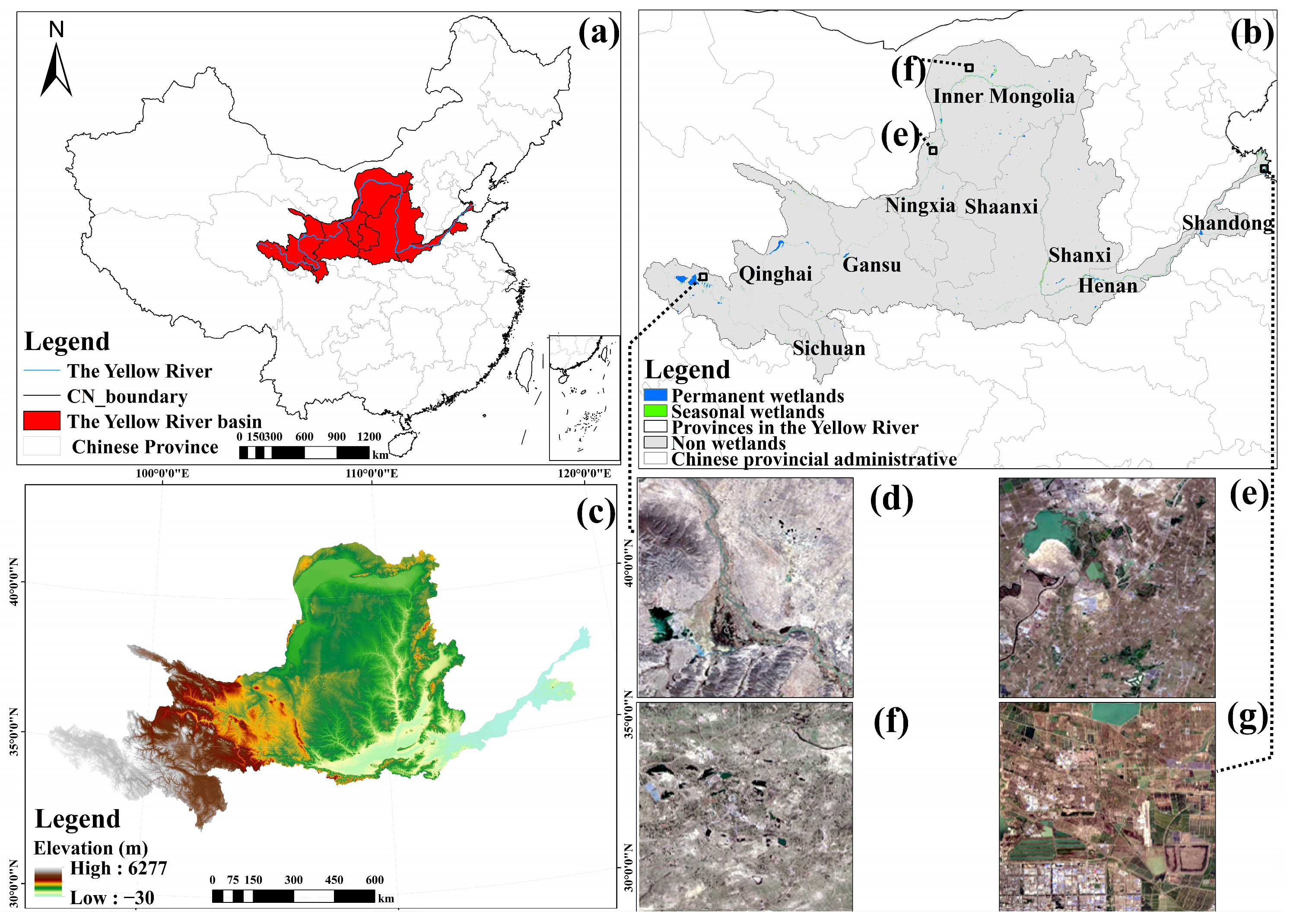



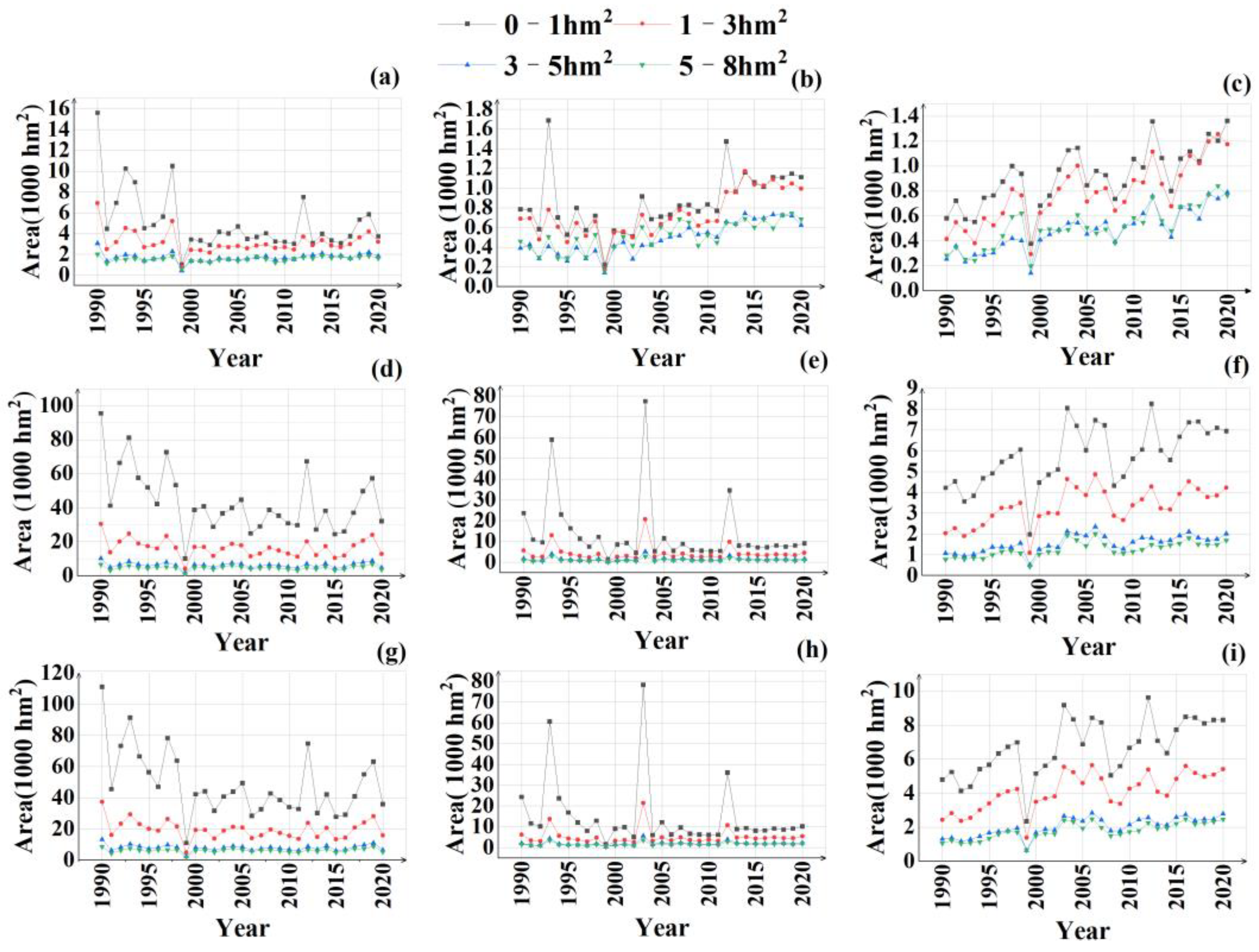

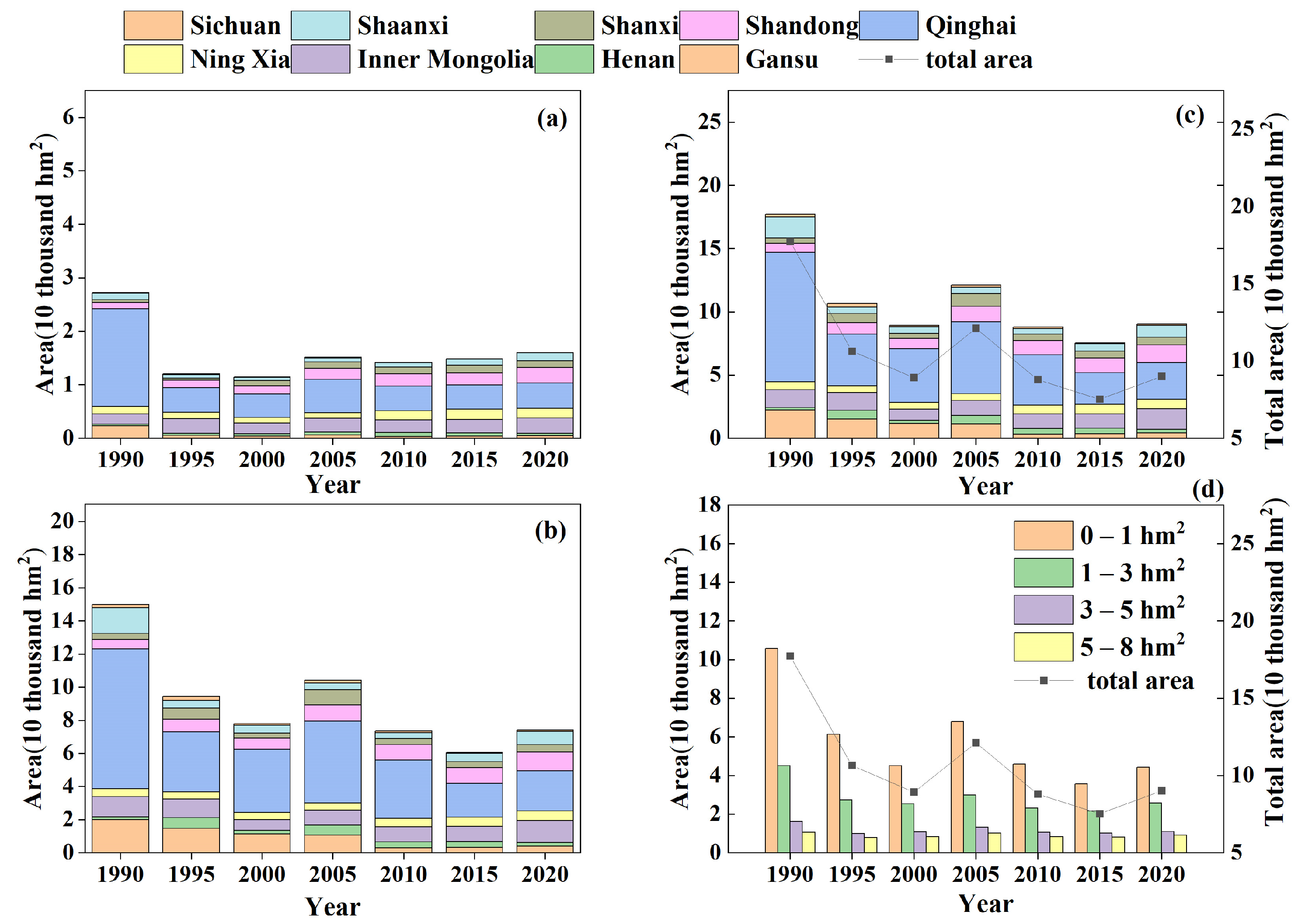

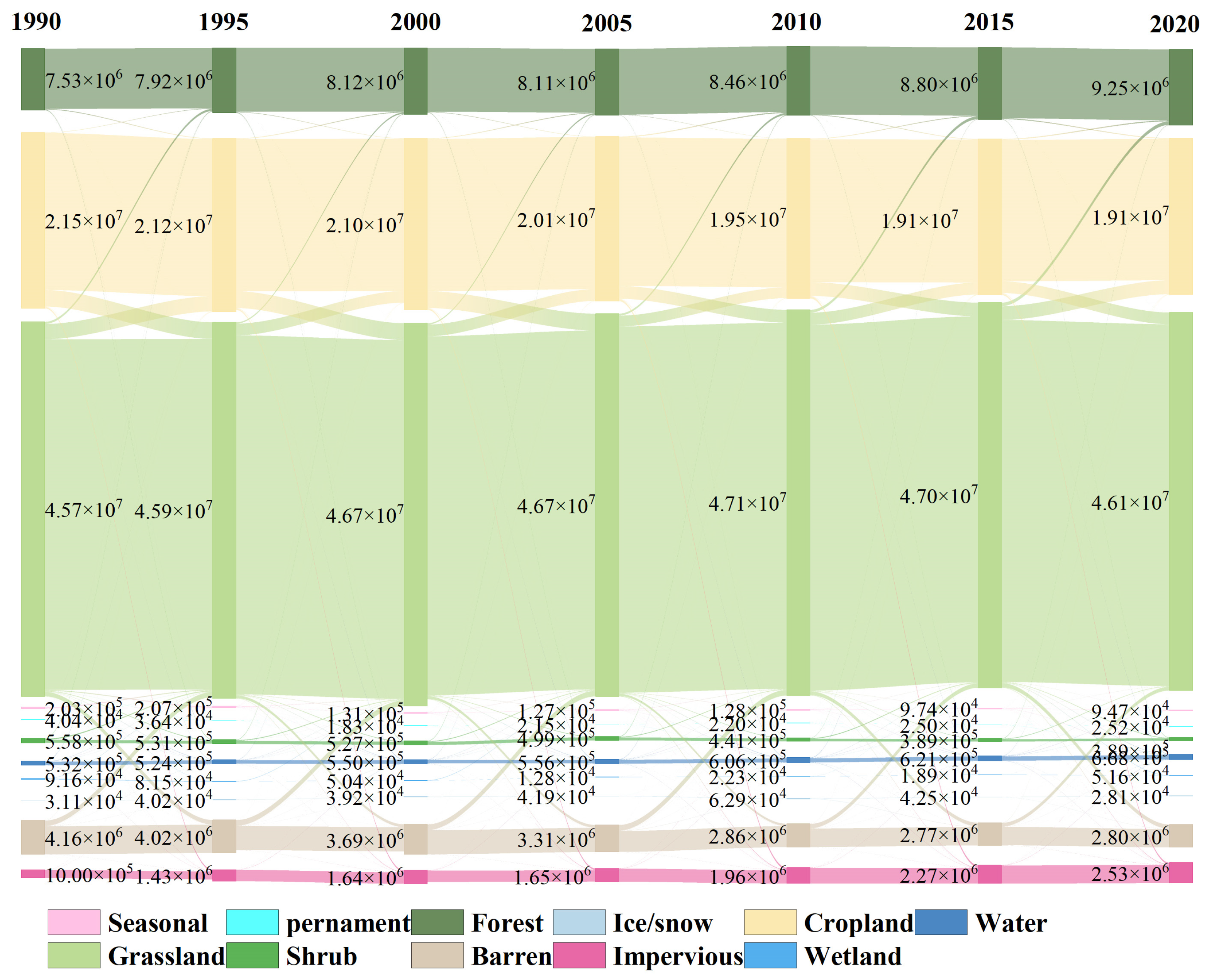
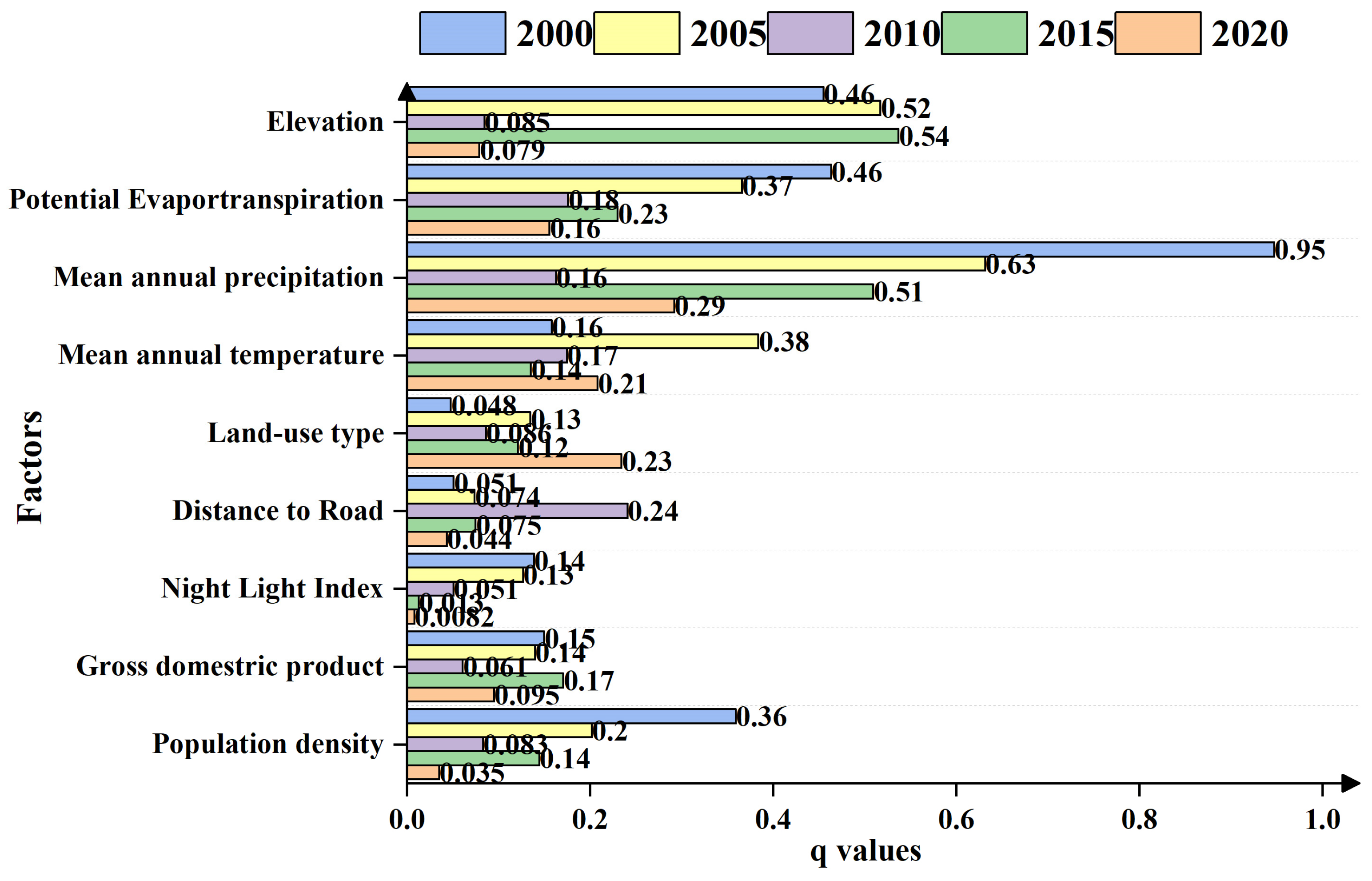

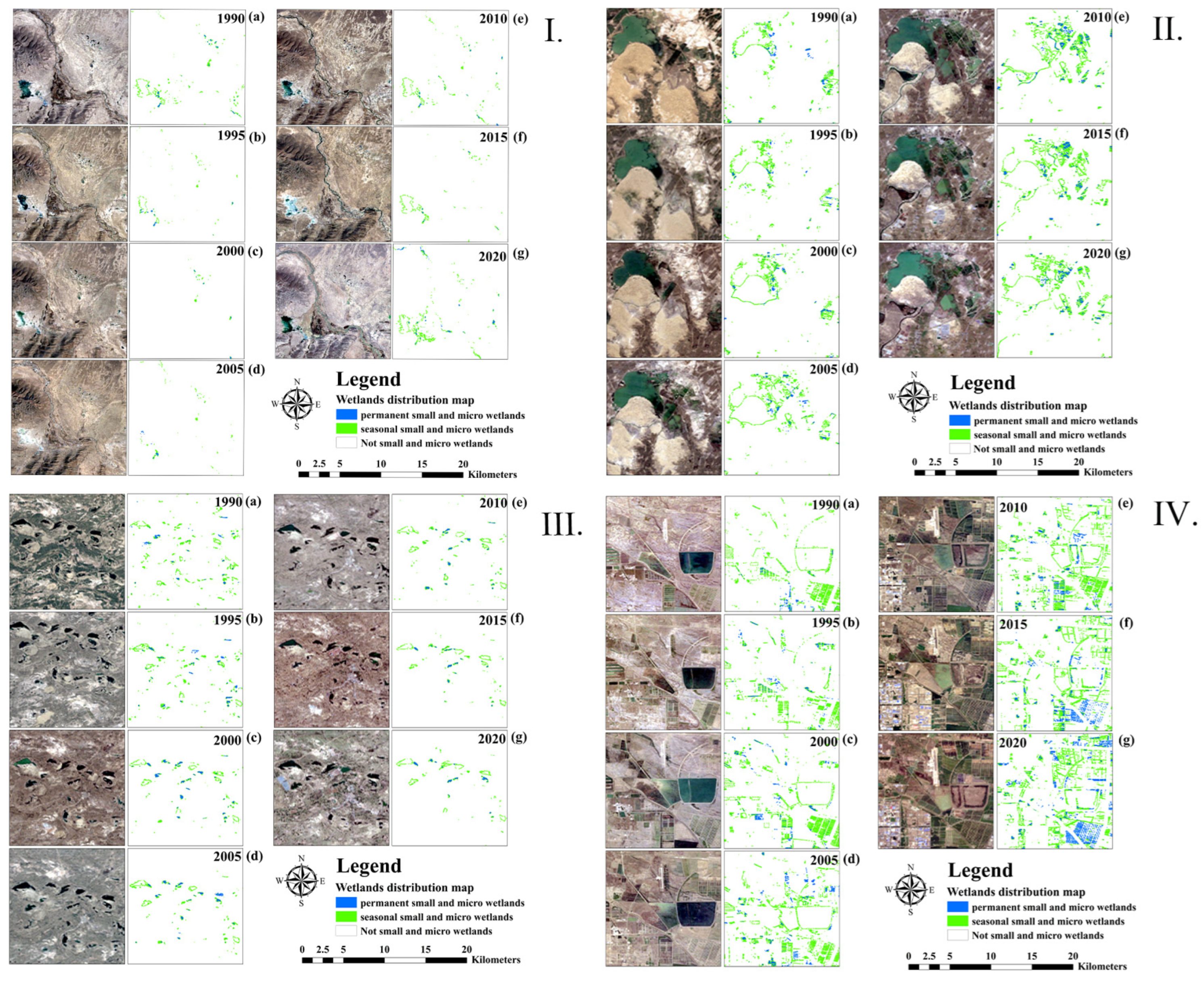

| Data Type | Data | Time | Number of Scenes | Spatial Resolution (m) | Source |
|---|---|---|---|---|---|
| Remote sensing | Landsat 4 | 1992–1993 | 21 | 30 × 30 | http://www.usgs.gov/ (accessed on 31 December 2020) |
| Landsat 5 | 1990–2011 | 22,713 | 30 × 30 | ||
| Landsat 7 | 1999–2020 | 24,663 | 30 × 30 | ||
| Landsat 8 | 2013–2020 | 11,199 | 30 × 30 | ||
| Google Earth image | 31st December 1990–2020 | 28 | https://earth.google.com.hk/ (accessed on 16 July 2023) | ||
| Raster data | Open-surface water body | 1990–2020 | 30 × 30 | Our research group (accessed on 6 January 2023) | |
| Vector data | Lake of the Yellow River Water system data of the Yellow River Administrative boundary China boundary | 1990–2020 2002–2017 2019 2020 | 1:250,000 1:1,000,000 1:1,000,000 1:14,000,000 | http://www.geodata.cn (accessed on 20 May 2023) https://www.webmap.cn/store.do?method=store&storeId=2 (accessed on 20 March 2023) bzdt.ch.mnr.gov.cn (accessed on 25 January 2024) | |
| Natural factors | Temperature | 1990–2020 | 1000 × 1000 | Shouzhang Peng et al. [49]: https://zenodo.org/records/3185722, (accessed on 21 April 2023) https://zenodo.org/records/3114194 (accessed on 25 April 2023) | |
| Precipitation | 1990–2020 | 1000 × 1000 | http://www.gscloud.cn (accessed on 21 March 2023) | ||
| Evaporation | 1990–2020 | 1000 × 1000 | |||
| Elevation | 2020 | 1000 × 1000 | |||
| Anthropogenic factors | Population density | 2000–2020 | 1000 × 1000 | http://www.resdc.cn (accessed on 16 May 2023) | |
| Gross Domestic Product | |||||
| Night Light Index | 2000–2020 | 1000 × 1000 | http://www.geodata.cn (accessed on 25 May 2023) | ||
| Road | 2000–2020 | / | http://geodata.pku.edu.cn (accessed on 16 August 2023) https://www.openstreetmap.org (accessed on 25 June 2023) | ||
| Land use Land cover | 1990, 1995, 2000, 2005, 2010, 2015, 2020. | 30 × 30 | Yang J, Huang X, Wuhan University [50]: https://zenodo.org/records/5816591#.ZAWM3BVBy5c (accessed 19 May 2023) |
| Categories | Factors | Code | Unit |
|---|---|---|---|
| Anthropogenic activity | Population density | X1 | person/km2 |
| Gross Domestic Product | X2 | 104 yuan/km2 | |
| Night Light Index | X3 | % | |
| Distance to main roads | X4 | km | |
| Land use type | X5 | categorical | |
| Climate elements | Average annual temperature | X6 | °C |
| Average annual precipitation | X7 | mm | |
| Potential evapotranspiration | X8 | mm | |
| Topography | Elevation | X9 | m |
| Categories/ Factors | Average Annual Temperature | Average Annual Precipitation | Potential Evapotranspiration | Elevation | Population Density | GDP | Night Light Index | Land Use Type | Distances to Road |
|---|---|---|---|---|---|---|---|---|---|
| 1 | −18.1~−6.3 | 99.9–216.1 | 12.1–45.4 | −30.0–637.8 | 0–100 | 0–50 | 0–1 | Cropland | 0–2 |
| 2 | −6.2~−4.1 | 216.2–295.6 | 45.5–53.7 | 637.9–1181.9 | 100–200 | 50–100 | 1–3 | Forest | 2–4 |
| 3 | −4.0~−1.5 | 295.7–362.9 | 53.8–61.9 | 1182–1627.1 | 200–400 | 100–200 | 3–5 | Shrub | 4–6 |
| 4 | −1.4–1.3 | 363.0–427.1 | 62.0–70.1 | 1627.2–2196.0 | 400–600 | 200–300 | 5–7 | Grassland | 6–8 |
| 5 | 1.4–4.3 | 472.2–491.3 | 70.2–78.0 | 2196.1–2913.3 | 600–800 | 300–500 | 7–9 | Water | 8–12 |
| 6 | 4.4–7.1 | 491.4–546.3 | 78.1–85.8 | 2913.4–3506.9 | 800–1000 | 500–1000 | 9–11 | Snow/Ice | 12–14 |
| 7 | 7.2–9.0 | 546.4–604.4 | 85.9–93.3 | 3507.0–3976.8 | 1000–1500 | 1000–2000 | 11–13 | Barren | 14–16 |
| 8 | 9.3–12.2 | 604.5–677.8 | 93.4–101.1 | 3976.9–4397.3 | 1500–2000 | 2000–3000 | 13–15 | Impervious | 16–18 |
| 9 | 12.3–16.0 | 677.9–879.6 | 101.2–112.1 | 4397.4–6277 | 2000–36,794 3000–542,505 | 15–63 | Wetland | 18–30 | |
| Illustrations | Interaction Relationship | Interaction |
|---|---|---|
| 1 | ) | Enhanced, nonlinear |
| 2 | Independent | |
| 3 | Enhanced, bilinear | |
| 4 | Weakened, single-factor nonlinear | |
| 5 | Weakened, nonlinear |
| Region Name | Year | Classification Accuracy (%) | Overall Accuracy (%) | Kappa Coefficient | |
|---|---|---|---|---|---|
| Permanent SMWs | Seasonal SMWs | ||||
| 1 Hajiang Salt Lake | 1990 | 88.8 | 87.2 | 88.0 | 0.79 |
| 1995 | 98.8 | 91.2 | 95.1 | 0.91 | |
| 2000 | 85.2 | 87.7 | 86.9 | 0.74 | |
| 2005 | 99.0 | 81.0 | 90.5 | 0.83 | |
| 2010 | 74.4 | 80.0 | 77.2 | 0.63 | |
| 2015 | 92.8 | 89.2 | 91.0 | 0.83 | |
| 2020 | 73.6 | 83.6 | 78.6 | 0.65 | |
| 2 Sand Lake | 1990 | 96.8 | 89.2 | 93.0 | 0.87 |
| 1995 | 99.6 | 90.0 | 94.8 | 0.90 | |
| 2000 | 95.2 | 86.0 | 90.6 | 0.83 | |
| 2005 | 94.0 | 85.6 | 89.8 | 0.81 | |
| 2010 | 94.8 | 90.8 | 92.8 | 0.87 | |
| 2015 | 97.6 | 90.0 | 93.8 | 0.88 | |
| 2020 | 99.2 | 84.4 | 91.8 | 0.85 | |
| 3 Shenglihaizi Lashanmiaohaizi et al. lake groups | 1990 | 98.0 | 86.0 | 92.0 | 0.84 |
| 1995 | 98.0 | 94.0 | 96.0 | 0.92 | |
| 2000 | 96.0 | 86.0 | 91.0 | 0.83 | |
| 2005 | 96.0 | 80.0 | 88.0 | 0.79 | |
| 2010 | 99.0 | 86.0 | 93.0 | 0.87 | |
| 2015 | 92.0 | 80.0 | 86.0 | 0.75 | |
| 2020 | 88.0 | 90.0 | 89.0 | 0.80 | |
| 4 The region of Yellow River Delta | 1990 | 95.6 | 93.2 | 94.4 | 0.89 |
| 1995 | 98.0 | 96.0 | 97.0 | 0.94 | |
| 2000 | 98.0 | 96.0 | 97.0 | 0.94 | |
| 2005 | 96.4 | 94.8 | 95.6 | 0.92 | |
| 2010 | 96.4 | 88.4 | 92.4 | 0.86 | |
| 2015 | 99.6 | 95.2 | 97.2 | 0.95 | |
| 2020 | 99.2 | 97.2 | 98.2 | 0.96 | |
| Average | 94.3 | 88.5 | 91.5 | 0.84 | |
| Specific Events | Number | Period | Study Area | Impact on Wetlands |
|---|---|---|---|---|
| Tourism | 1 | 1984–2011 | North of Zhengzhou city | A further destruction of wetlands [78] |
| 2 | 2011 | Zhengzhou Yellow River Wetland Nature Reserve | The harm of tourism is lighter [79] | |
| 3 | 2017–2021 | The Yellow River Estuary | The negative effects first increase and then decrease [80] | |
| Water pollution | 4 | 1991–2020 | The Yellow River Delta | Negative effects [81] |
| 5 | 2018 | Wetlands along the Yellow River in Henan Province | Destruction of the ecological functions of wetland [82] | |
| 6 | 1983–2015 | The Yellow River Delta | Negative impacts [83] | |
| Storm | 7 | 2014 | The Yellow River Delta | May be submerged without damp proof [84] |
| 8 | 1976–2018 | The Yellow River Delta | Storm-induced erosion [85] | |
| Extreme weather | 9 | 1961–2021 | The upstream of Yellow River Basin | Disaster risk [86] |
| 10 | 1957–2018 | Chinese Loess Plateau | Rainfall erosivity [87] |
Disclaimer/Publisher’s Note: The statements, opinions and data contained in all publications are solely those of the individual author(s) and contributor(s) and not of MDPI and/or the editor(s). MDPI and/or the editor(s) disclaim responsibility for any injury to people or property resulting from any ideas, methods, instructions or products referred to in the content. |
© 2024 by the authors. Licensee MDPI, Basel, Switzerland. This article is an open access article distributed under the terms and conditions of the Creative Commons Attribution (CC BY) license (https://creativecommons.org/licenses/by/4.0/).
Share and Cite
Zhai, G.; Du, J.; Li, L.; Zhu, X.; Song, Z.; Wu, L.; Chong, F.; Chen, X. Spatiotemporal Dynamics and Driving Factors of Small and Micro Wetlands in the Yellow River Basin from 1990 to 2020. Remote Sens. 2024, 16, 567. https://doi.org/10.3390/rs16030567
Zhai G, Du J, Li L, Zhu X, Song Z, Wu L, Chong F, Chen X. Spatiotemporal Dynamics and Driving Factors of Small and Micro Wetlands in the Yellow River Basin from 1990 to 2020. Remote Sensing. 2024; 16(3):567. https://doi.org/10.3390/rs16030567
Chicago/Turabian StyleZhai, Guangqing, Jiaqiang Du, Lijuan Li, Xiaoqian Zhu, Zebang Song, Luyao Wu, Fangfang Chong, and Xiya Chen. 2024. "Spatiotemporal Dynamics and Driving Factors of Small and Micro Wetlands in the Yellow River Basin from 1990 to 2020" Remote Sensing 16, no. 3: 567. https://doi.org/10.3390/rs16030567
APA StyleZhai, G., Du, J., Li, L., Zhu, X., Song, Z., Wu, L., Chong, F., & Chen, X. (2024). Spatiotemporal Dynamics and Driving Factors of Small and Micro Wetlands in the Yellow River Basin from 1990 to 2020. Remote Sensing, 16(3), 567. https://doi.org/10.3390/rs16030567











